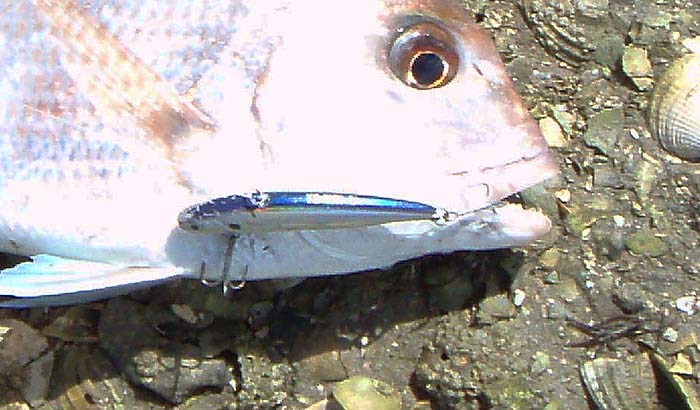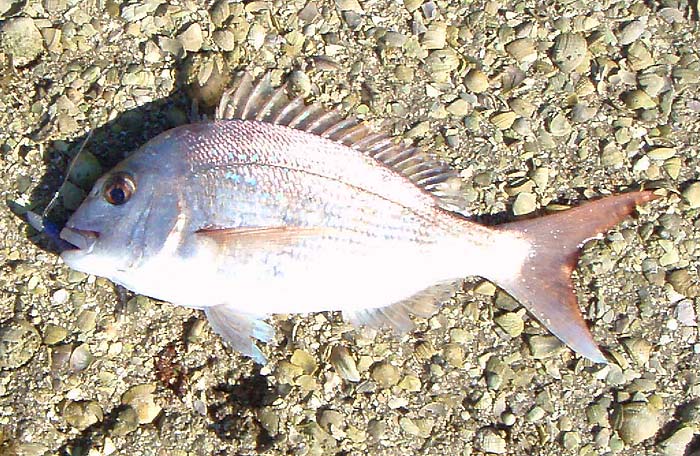
Information Page.
New Zealand salt.
Alan Bulmer sent me this email from New Zealand recently and I thought it was worth repeating as a spot of real sea angling info. during my river fishing season.
Hi Mike,
I hope that you and the family enjoyed a relaxing, fun filled Christmas and that 2008 is a successful and healthy year for you all.
I read your story about catching pike on large rubber lures and it sounded right up my alley! More by circumstance than premeditation, most of my fishing at Whangamata over Christmas also involved the use of soft plastic lures.
We towed the boat (or should I say trailer - as it was laden to the gunwales with kayaks, bikes, boogie boys and other teenage boy paraphernalia) down to Whangamata early on Christmas eve and arrived at morning tea time. The weather was bright and sunny with the occasional blotch of cloud, the wind was gusting from the NE at 15 knots and the temperature was a pleasant 22oC. I had an early lunch and trotted across the mudflats at 12.30 hours, an-hour-and-a-half before dead low tide. I started fishing under the boats with a Sassy shad as this had brought reward earlier in 2007. After 45 minutes of fruitless casting I switched to a Yo-Zuri 3D vibe and fished the tide down. Nothing came to the lure but there were lots of baitfish clumped in the shallows and they were being casually harassed by small trevally. Unfortunately these trevally would not take lures, even small poppers, but the signs were promising.
The next time I was able to wangle a leave pass was on Boxing Day. The weather had taken a turn for the worse and it could best be described as changeable – hot and sunny one minute, squally showers the next but pleasantly warm overall. The only constant was the strong wind from the North West which was puffing steadily at 25 knots! I started off with a rig which incorporated an Eddystone eel as I thought this would tempt any larger predators in the vicinity. I was using the new Okuma dropshot rig and the wind made it difficult to control the braid and the drifting rig (conventional braid not fused). In frustration I switched to the Yo-Zuri 3D Vibe minnow as it was easier to control under the circumstances. Third cast and a fish slammed the lure in the middle of a slow, ripping retrieve. Braid poured off the spool initially as the fish headed off for deeper water under the nearest launch. I quickly tightened the drag which bent the rod into a working curve and was able to turn the fishes head and slowly work it back into the shallows using the current. I picked it for a Trevally or Kahawai but as it neared the shore it turned and flashed Orange before charging off on another run. Snapper! The feisty fish succumbed to the relentless pressure reasonably quickly and was beached without incident. This was my first 'hard bodied lure' Snapper at Whangamata.
I got out again on the 28 December and decided that it may be best to revert to 3” Berkeley Powerbait minnows on ¼ oz. jig heads, the idea being to target the Snapper that were obviously in the estuary (unlike 2006). Again the weather was hot and sunny when I hit the mud flats and the only relief from the oppressive heat was a light breeze from the NW. Upon reaching the estuary about 2 hours from dead low, I noticed that the outgoing tide was surging powerfully through a channel gouged near to my shore. I flicked out the soft bodied lure at 11 O’clock and allowed it to drift downstream through the gut on a tight line. It would have only travelled 12’ before it was slammed hard. The fish charged downstream ripping off line against a heavy drag. I immediately applied side strain and after 5 minutes of toing and froing a 1 ½ lb Snapper lay flapping on the shore. I released this fish and returned to the turbulent gut. Two casts later, the lure was crunched again as it jerked its way along the seabed. The line again sped off the reel and I caught a glimpse of gold the size of a small frying pan as it lunged back into the current. Another Snapper, slightly larger than the first soon made its way to the shore. This one was asked home for dinner. Unfortunately by now the tide had slackened and it was not long before the ¼ oz jighead became intimately acquainted with the horse mussel population (who felt they had a greater ownership claim). I replaced the lure with a slightly smaller jig head and proceeded to fish the current seams. About 15 minutes later I hooked and lost another fish just before the tide slackened off completely. To avoid more tackle losses I changed to the Yo-Zuri 3D Vibe and plugged the holes between the moored launches. I was just about to call it a day when the lure was spanked mid retrieve and a 30 cm Kahawai took to the air. This fish fought strongly but was no match for the braid and powerful drop shot rod. It was released to fight another day.
To cut a long story short, I went out three more times in the estuary and caught at least two Snapper on every outing. I started fishing about 1 hour earlier than normal to take advantage of the peak tidal flows through the channels close to the shore (and finished 1 hour earlier). All of the fish were 30 cm long and in peak condition. What is amazing is that I only caught one small Trevally on the soft baits and did not hook any Kahawai. Up until early 2007 I had only caught one Snapper at Whangamata and now it seems I may have figured out a system to target them regularly. Yahoo!
We went out a couple of times in the boat on the days that I did not fish in the estuary. The results were pretty patchy. Sandy cleaned up on Gurnard in the first outing when we were drift fishing. Sandy and the boys used bait while I chose to fish soft plastic. In the second outing, we encountered a work up and I immediately rigged up the boys rods with Rapala trolling lures. Hamish and Tim both hooked up within 5 minutes of the lures entering the water as we were careful to troll the perimeter of the work up. Hamish dropped his first fish but Tim was being tugged all over the back of the boat by a good fish. If he had of stuck the rod butt between his legs he would have ended up a eunuch. I picked it for a large ocean going Kahawai but it stayed deep which is a Kingfish trait. After 10 minutes of losing line, Tim gradually gained control and work the fish boat side. It fought every inch of the way to the net and when we finally saw colour it was 60 cm of prime Kingfish (around 6 lb). Too small to keep but great fun to catch and release. We reset the lures and Hamish immediately hooked up on a 50 cm Kingfish which also fought long and hard. The work up then sounded and we could not buy a fish trolling (although we did see two huge free jumping Mako sharks which may have been part of the problem!).
The Okuma set went flawlessly although the conventional braid was often a veritable pain to cast. It regularly tip wrapped and it was not until the line level on the spool reached 3/8” from the rim that the casting knots stopped. Fused braid (Fireline and Crystal Fireline) are much easier to use. I will be re-spooling before our summer holiday in mid January (Ohope and the Ohiwa harbour). The Okuma Salina 30 reel has a brilliant double drag system, is very robust and was a joy to use.
Best regards to you and yours. Tight lines!
Alan Bulmer
Ten minutes to land a six pound fish! That's what I call a battle. Kingfish obviously fight in the true 'jack' style. I can't wait for Alan's next report.
If you have any comments or questions about fish, methods, tactics or 'what have you.'get in touch with me by sending an E-MAIL to - docladle@hotmail.com
Snapper.

Another snapper.
 '
'Kingfish.
 '
'